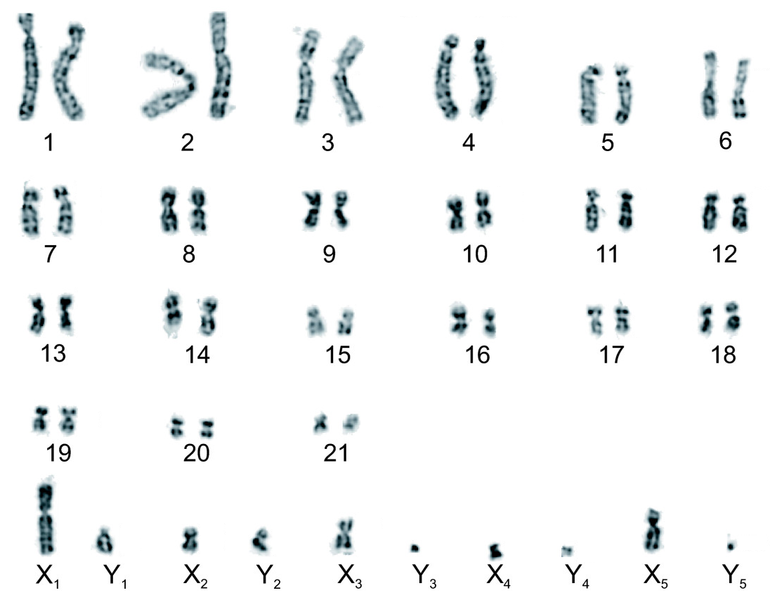GCSE Biology - AQA
2.2.4 - DNA in Eukaryotic and Prokaryotic Cells
Jump to:
DNA in Eukaryotic and Prokaryotic Cells
The form of the DNA, and its location within the cell, is different for eukaryotic cells and prokaryotic cells.
DNA in eukaryotic cells
In a eukaryotic cell, the DNA is in the form of linear chromosomes, located in the nucleus.

The DNA in eukaryotic cells is in the form of linear chromosomes, located in the nucleus.
In many eukaryotic cells, including human body cells, the chromosomes come in pairs. The two chromosomes in each pair have the same genes, but they may have different versions of those genes. This will be explained in more detail later in the course.

In many eukaryotic cells, the chromosomes come in pairs.
The number of chromosomes in the nucleus varies greatly between different species. Some examples are given in the table below:
| Species | Number of chromosomes |
|---|---|
| Fruit fly | 4 pairs (8 chromosomes) |
| Spinach | 6 pairs (12 chromosomes) |
| Kangaroo | 8 pairs (16 chromosomes) |
| Budding yeast | 16 pairs (32 chromosomes) |
| Human | 23 pairs (46 chromosomes) |
| Pineapple | 25 pairs (50 chromsomes) |
| Platypus | 26 pairs (52 chromosomes) |
| Pigeon | 40 pairs (80 chromosomes) |
| Grape fern | 45 pairs (90 chromosomes) |
| Adders-tongue fern | 630 pairs (1260 chromosomes) |
The diagram below shows all of the chromosomes from the nucleus of a body cell from a male platypus. A platypus has 26 pairs of chromosomes in total, of which 5 pairs are sex chromosomes (humans only have one pair of sex chromosomes).
Each chromosome is an X-shape, indicating that DNA replication has already taken place.

Diagram showing all of the chromosomes in a cell of a male platypus. The X and Y chromosomes are sex chromosomes. Image: Rens et al. via Wikimedia Commons (CC BY 2.0 - https://creativecommons.org/licenses/by/2.0/)

A platypus. Image: Klaus via Wikimedia Commons (CC BY-SA 2.0 - https://creativecommons.org/licenses/by-sa/2.0/deed.en)
DNA in prokaryotic cells
Prokaryotic cells do not have a nucleus - instead the DNA is found in the cytoplasm.
Each prokaryotic cell has a single circular chromosome.
In addition to the chromosome, prokaryotic cells often also contain plasmids. The number of plasmids varies between different prokaryotic cells.

Diagram of a prokaryotic cell containing a single circular chromosome and three plasmids. Note that the plasmids are much smaller than the chromosome.
Beyond the Syllabus: Exceptions to the rules
The information above is what you need to know for the GCSE course. However, there are some exceptions to some of the statements made above. If you just want to know what you need for the exams, then you can skip this section. But if you are curious, then read on.
Exceptions to the rules:
- There are examples of prokaryotic cells that have more than one chromosome.
- There are examples of prokaryotic cells that have linear chromosomes.
- Plasmids are sometimes linear.
- Plasmids are sometimes found in eukaryotic cells - especially unicellular fungi (yeasts).
Flashcards
Flashcards help you memorise information quickly. Copy each question onto its own flashcard and then write the answer on the other side. Testing yourself on these regularly will enable you to learn much more quickly than just reading and making notes.
1/2
What form is the DNA of eukaryotic cells in?
2/2
What form is the DNA of prokaryotic cells in?
Next Page
3.1.1 - Solutions, Solutes and Solvents
Previous Page
2.2.3 - Chromosomes and Plasmids
Return to course page
Donate
Please consider donating to support Mooramo. I am one person doing this whole project on my own - including building the site, writing the content, creating illustrations and making revision resources. By making a one-time or repeating donation you will buy me time to work on Mooramo, meaning that I can get new content on here more quickly.
Donate